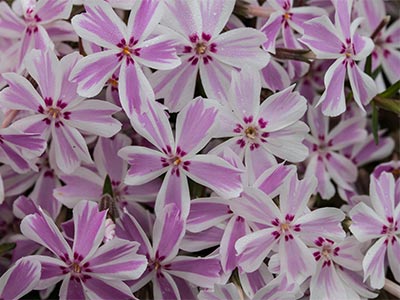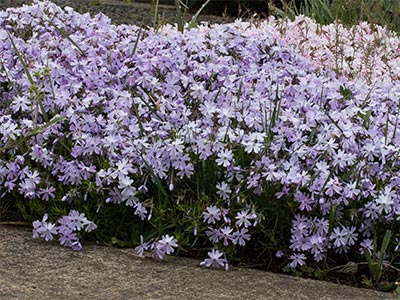Moss Phlox
- Scientific Name: Phlox subulata
- Garden: Lawn Alternatives Garden
- Plant Type: Ground Cover
- Evergreen/Deciduous: Evergreen
- Sun/Shade Exposure: Full Sun
- Moisture Requirements: Moist, Well-Drained
Plant Information
Phlox subulata, commonly called moss phlox, moss pink, mountain phlox or creeping phlox, is a vigorous, spreading, mat-forming, sun-loving phlox that grows to only 6” tall but spreads to 24” wide. It is noted for its creeping habit, its linear to awl-shaped leaves (which retain some green in winter) and its profuse carpet of mid-spring flowers with notched flower petals. It is native to somewhat dry, rocky or sandy places, open woodland areas and slopes from Michigan, Ontario and New York south to Tennessee and mainly in the Appalachians to North Carolina. Loose clusters (cymes) of fragrant, tubular flowers (to 3/4” wide) bloom in April-May. Flowers are red-purple to violet-purple, pink or infrequently white. Each flower has five, flat, petal-like, rounded lobes that are distinctively notched. Linear to awl-shaped, green leaves (to 1” long). From Latin, subulata means awl-shaped in reference to the leaves. Vegetation mats purportedly resemble moss, hence the common name of moss phlox.
Culture:
Best grown in humusy, medium moisture, well-drained soils in full sun. Best flowering is in full sun, but plants generally appreciate some dappled sun in areas with hot, humid summers. Good soil drainage is important. Plants grow well in sandy or gravelly soils and tolerate hot, dry exposures better than most other species of phlox. Plants will self-seed in optimum growing conditions. Cut back stems after flowering by 1/2 to maintain form and promote denser growth plus to stimulate a possible light rebloom.Data Source
https://www.portlandnursery.comPlant Photos





